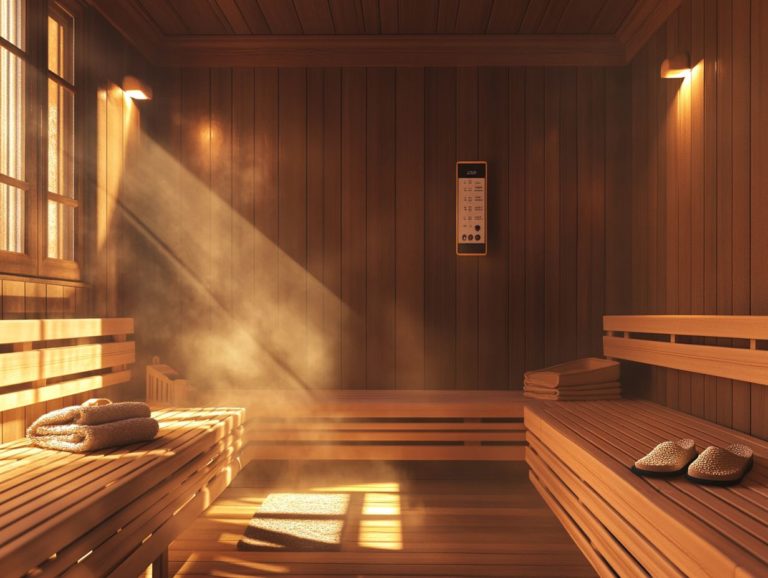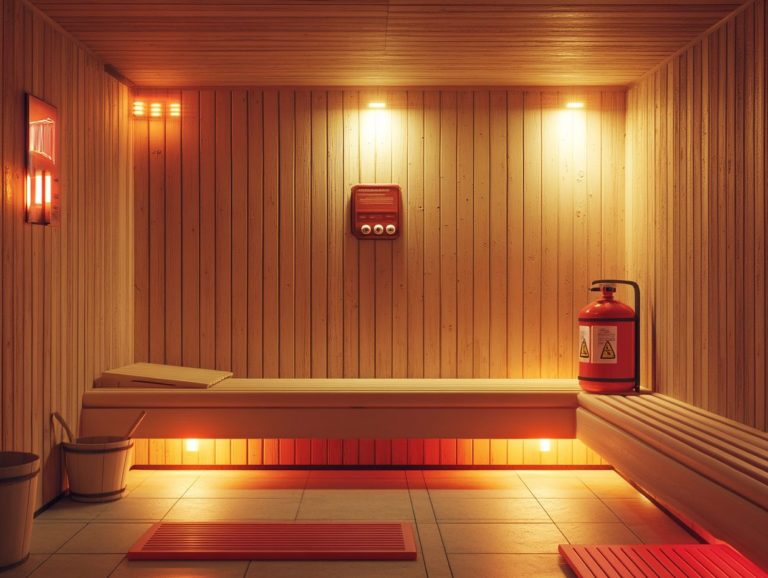Sauna Safety: The Importance of Knowledge
Saunas have long been revered for their soothing and revitalizing qualities, yet truly understanding them involves more than simply basking in the warmth.
This article delves into the various types of sauna bathing and their distinctive features, illuminating the myriad physical and mental health benefits they provide. It s essential for you to be aware of potential risks and the necessary safety measures to ensure a secure and enjoyable experience.
You ll find valuable tips on proper use and maintenance that will enable you to maximize the benefits of your sauna sessions.
Discover everything you need to know about saunas!
Contents
- Key Takeaways:
- What is a Sauna?
- Benefits of Sauna Use
- Potential Risks and Dangers
- Precautions for Sauna Use
- Proper Use and Maintenance of Saunas
- Frequently Asked Questions
- What is the importance of knowledge in sauna safety?
- How does having knowledge about saunas contribute to safety?
- Are there any specific safety precautions one should take in a sauna?
- What are some potential risks and hazards associated with saunas?
- Can individuals with certain health conditions, such as heart disease, safely use saunas?
- How can one educate themselves about sauna safety and benefits?
Key Takeaways:

- Always educate yourself on the different types of saunas and their specific safety guidelines to ensure a safe and enjoyable experience.
- Regular sauna use has numerous physical and mental health benefits, but it’s important to also understand and mitigate potential risks and dangers.
- Proper use and maintenance of saunas, including following safety precautions and measures, is key to maximizing the benefits and avoiding harm.
What is a Sauna?
A sauna is a comfortable space, crafted to reach high temperatures, usually between 70 to 100 degrees Celsius.
This unique experience of heat exposure has earned immense popularity across various cultures, especially in Finland, where the tradition runs deep.
Saunas can be made from a variety of materials, with wood being a classic choice. They’re not just about warmth; they often serve as the centerpiece of relaxation and social gatherings, offering a wealth of health benefits associated with keeping your body warm and hydrated and the perks of sweating. Understanding the role of sauna safety in holistic health is essential to maximize these benefits.
You ll find different types of saunas, including the traditional Finnish sauna, a hallmark of relaxation in Finland, which harnesses either steam or dry heat to enhance both mental health and physical wellness.
Types of Saunas and Their Differences
Saunas come in a variety of types, each boasting its own unique characteristics. Among the most noteworthy are the Finnish sauna, infrared sauna, and steam room, each offering distinct benefits tailored to your individual preferences.
The Finnish sauna operates at a higher temperature, typically between 150 F and 195 F (65 C to 90 C). The low humidity creates a dry heat that penetrates deeply into your muscles. You might even indulge in traditional practices, like using birch tree whisks known as vihta or vasta, enhancing circulation and rejuvenating your skin through gentle tapping.
The infrared sauna offers a milder experience, usually ranging from 110 F to 140 F (43 C to 60 C). This sauna delivers direct heat that penetrates your skin, making it an excellent choice if you seek pain relief or prefer a milder sauna session.
Steam rooms, on the other hand, maintain a humid environment at about 100 F to 120 F (38 C to 49 C), promoting respiratory benefits and hydration while helping to ease muscle tension.
Each of these distinct features adds to the enriching experience, making saunas a valuable resource for relaxation, detoxification, and your overall well-being.
Benefits of Sauna Use
The advantages of using a sauna go far beyond simple relaxation. You ll find that it significantly enhances cardiovascular health, boosts mental well-being, and promotes muscle relaxation, including pain relief.
This approach to wellness is backed by research, with empirical studies demonstrating its positive effects on blood pressure and heart disease. Embracing sauna sessions can be a transformative addition to your overall health regimen, especially when you understand the importance of sauna safety training.
Physical and Mental Health Benefits

Experience thrilling muscle relaxation along with heightened endorphin levels and improved cardiovascular health. These benefits work together to reduce chronic pain and rheumatoid arthritis, alleviating symptoms of conditions like asthma.
But the advantages don’t stop there. Many individuals report a profound sense of well-being following a sauna session. They credit this feeling to the comforting heat that eases both body and mind, but it’s important to remember sauna safety and understanding your limits for a safe experience.
Research backs up this personal experience, demonstrating that the warmth of a sauna induces widening of blood vessels, aiding in muscle recovery and alleviating tension. The endorphin release elevates your mood, often linked to improved oxygen delivery, offering a natural form of happiness that lingers well after you step out.
Studies show that regular sauna use can significantly decrease anxiety levels. This practice enhances overall mental health and should be part of your wellness routine.
Potential Risks and Dangers
While sauna bathing can provide you with a wealth of health benefits, it s crucial to remain mindful of the potential risks and dangers involved.
Consider the dehydration risk and possible complications for individuals with chronic musculoskeletal diseases like rheumatoid arthritis or those taking neuroleptics. This highlights the significance of prioritizing sauna safety: the importance of connection, particularly for individuals on neuroleptics, in your wellness routine.
Understanding Sauna Safety
Understanding sauna safety is essential for you to fully enjoy the benefits while minimizing any risks, particularly if you have pre-existing health conditions like heart disease or chronic pain. It s equally important to be aware of dehydration risks and temperature regulation when exposed to heat for extended periods.
Limit your sauna sessions to 15-20 minutes, especially if you’re a beginner. Hydration is key; drink water before, during, and after your session to stave off dehydration and support your overall health. Additionally, understanding sauna safety can enhance your experience and promote personal growth.
Monitor your body temperature and be in tune with how you’re feeling. If you start to feel dizzy, nauseous, or uncomfortable in any way, don’t hesitate to exit the sauna. Additionally, understanding sauna safety and the importance of consultation can help ensure that you prioritize your well-being. By being mindful of these safety measures, you can truly enjoy the relaxation and therapeutic benefits.
Precautions for Sauna Use
Implementing crucial safety measures before stepping into a sauna is vital, especially for those at risk of dehydration or individuals with health concerns such as heart disease. This attention to detail ensures you can enjoy a safe and pleasurable experience in the soothing heat.
Important Safety Measures

Key safety measures for sauna use include sticking to recommended durations, staying well-hydrated, and keeping an eye on your body temperature to prevent overheating and ensure a pleasant experience.
It’s crucial for you to tune into the signals your body sends. These cues can indicate when it’s time for a break or when you need to hydrate further. Understanding the importance of hydration elevates your overall sauna experience by keeping your energy levels up and aiding in detoxification. For more insights, check out sauna safety and reflection.
Being mindful of your body temperature not only helps prevent issues like dehydration or heat exhaustion but also allows you to fully enjoy the sauna s therapeutic benefits without compromising safety.
Regularly checking in with your personal comfort levels ensures that each session is both enjoyable and beneficial.
Proper Use and Maintenance of Saunas
Proper use and maintenance of saunas are essential for ensuring your safety and extending the longevity of this luxurious retreat. This involves regular cleaning and following effective usage guidelines, which together help maintain a healthy and inviting environment for your relaxation.
Tips for Safe and Effective Use
To enjoy a safe sauna experience, stay hydrated. Keep an eye on your body temperature.
Follow maintenance tips for a clean environment. Drinking a glass of water before and after your session is key.
Sessions typically last around 15 to 20 minutes. Listen to your body and adjust as needed.
Regularly check the sauna for mold and bacteria. Proper ventilation is essential.
Establish a routine by using the sauna two to three times a week. This promotes relaxation and wellness while also benefiting from community sauna safety programs.
Frequently Asked Questions
What is the importance of knowledge in sauna safety?

Understanding sauna safety helps you recognize risks and avoid accidents.
How does having knowledge about saunas contribute to safety?
Knowing how to use a sauna safely helps you decide how long to stay and when to take breaks. This prevents overheating and health issues.
Are there any specific safety precautions one should take in a sauna?
Stay hydrated and listen to your body. Avoid alcohol and drugs before using the sauna, and bring a buddy for emergencies.
What are some potential risks and hazards associated with saunas?
Risks include dehydration, heatstroke, burns, and suffocation. Awareness is key to avoiding these dangers.
Can individuals with certain health conditions, such as heart disease, safely use saunas?
People with conditions like high blood pressure or heart disease should consult a doctor before using a sauna. Safety comes first.
How can one educate themselves about sauna safety and benefits?
Research online and read guidelines from sauna manufacturers. Workshops and classes are also great ways to learn about sauna safety.





